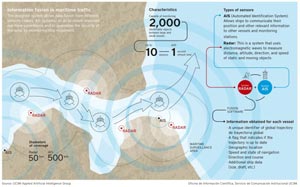An intelligent system for maritime surveillance has been created

The system has been designed by scientists from this Madrid university for Núcleo CC, a company which develops surveillance systems for the maritime and aeronautic sectors. The first prototype will be used in the near future in Cape Verde (Africa).
Two types of sensors have been deployed there: a set of radars and a series of AIS (Automatic Identification System), which allow ships to communicate their position and give other relevant data on their location and characteristics. These two types of sensors offer complementary data which can be fused in order to obtain better information as to what is happening in the maritime and coastal space of the area of interest.
This has been achieved by the scientists from the Applied Artificial Intelligence Group (GIAA) of UC3M, who have carried out the project “Fusión de Información en Tráfico Marítimo” (Information Fusion in Marine Traffic).
The results of this research, presented last July at the International Conference on Information Fusion in Edinburgh, Scotland, has been the creation of data fusion software which allows improved maritime surveillance to be carried out, simultaneously integrating the capabilities of the radars and the AIS localization stations deployed. The objective is to guarantee security in the area by monitoring the different ships that are in a given maritime route which, at the same time is the entrance and exit of a commercial port. “For that”, Jesus Garcia, one of the heads of the study from the UC3M Department of Information Technology, pointed out, “it is necessary to have a complete, accurate, and up to date picture, similar to that which is provided to air traffic controllers, of all the ships that are in the area of coverage to be able to adequately manage maritime traffic and to detect anomalies as much in advance as possible”.
The scientists developed a prototype which has been integrated into the company’s system, after having undergone validation tests to be able to execute in real time with the data supplied by its sensors. It able to monitor 2,000 identifiable objectives between large and small vessels, with a capacity to process the data of up to 10 sensors and provide the exit with one second refresh time. “Ships have to be able to localized 24 hours a day, 7 days a week, 365 days a year, independent of failures in the sensors or in the different intermediate mechanisms, and in some way, what this system attempts to do is guarantee that this can be done”, explained José Luis Guerrero, another of the GIAA group researchers, who worked on this project from the UC3M Colmenarejo Campus. “In this way”, he continued”, we are able to make it so these vessels never lose their position thus avoiding collisions or any type of problem in information management regarding the movement dynamics of these ships”.
This first prototype opens the way for posterior analysis and development, as more data and information regarding its functioning under real conditions are obtained, the scientists noted, who are now researching how to apply this information fusion technology to fields such as robotics, in unmanned vehicle navigation, artificial vision, or environmental intelligence systems. “In all of these areas”, Professor Jesus Garcia pointed out, “information fusion technology and infrastructure are necessary to combine the data from available sensors and the contextual information in each scenario”.
Further Information:
Tittle: Robust Sensor Fusion in Real Maritime Surveillance Scenarios
Authors: Jesús García, José Luís Guerrero, Álvaro Luís y José M. Molina.
Resource: Proceedings of the 13th International Conference on Information Fusion
Edinburgh, UK: July 26-29, 2010.
ISBN: 978-0-9824438-1-1
Media Contact
More Information:
http://www.uc3m.esAll latest news from the category: Information Technology
Here you can find a summary of innovations in the fields of information and data processing and up-to-date developments on IT equipment and hardware.
This area covers topics such as IT services, IT architectures, IT management and telecommunications.
Newest articles

Properties of new materials for microchips
… can now be measured well. Reseachers of Delft University of Technology demonstrated measuring performance properties of ultrathin silicon membranes. Making ever smaller and more powerful chips requires new ultrathin…

Floating solar’s potential
… to support sustainable development by addressing climate, water, and energy goals holistically. A new study published this week in Nature Energy raises the potential for floating solar photovoltaics (FPV)…

Skyrmions move at record speeds
… a step towards the computing of the future. An international research team led by scientists from the CNRS1 has discovered that the magnetic nanobubbles2 known as skyrmions can be…





















